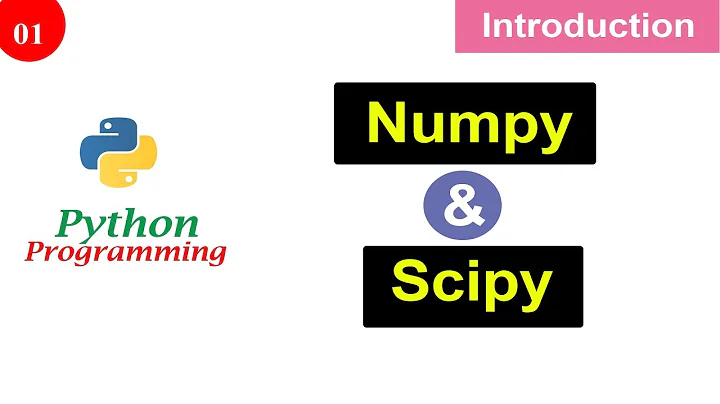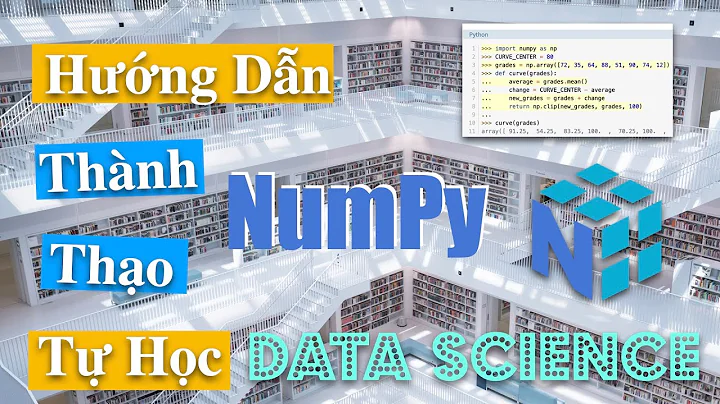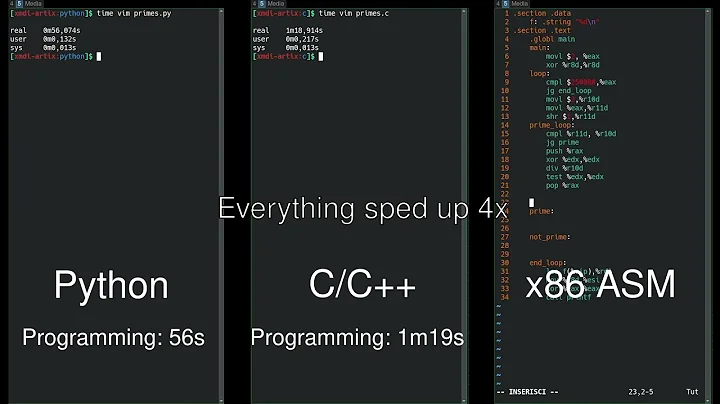How much of NumPy and SciPy is in C?
Solution 1
-
I would question any benchmark which doesn't show the source for each implementation (or did I miss something)? It's entirely possible that either or both of those solutions are coded badly which would result in an unfair appraisal of either or both language's performance.[Edit] Oops, now I see the source. As others have pointed out though, it's not using the NumPy/SciPy libraries so those benchmarks are not going to help you make a decision. - I believe the vast majority of NumPy and SciPy is written in C and wrapped in Python for ease of use.
- It probably depends what you're doing in any of those languages as to how much overhead there is for a particular application.
I've used Python for data processing and analysis for a couple of years now so I would say it's certainly fit for purpose.
What are you trying to achieve at the end of the day? If you want a fast way to develop readable code, Python is an excellent option and certainly fast enough for a first stab at whatever it is you're trying to solve.
Why not have a bash at each for a small subset of your problem and benchmark the results in terms of development time and run time? Then you can make an objective decision based on some relevant data ...or at least that's what I'd do :-)
Solution 2
There is a better comparison here (not a benchmark but shows ways of speeding up Python). NumPy is mostly written in C. The main advantage of Python is that there are a number of ways of very easily extending your code with C (ctypes, swig,f2py) / C++ (boost.python, weave.inline, weave.blitz) / Fortran (f2py) - or even just by adding type annotations to Python so it can be processed to C (cython). I don't think there are many things comparably easy for C# or Java - at least that so seemlessly handle passing numerical arrays of different types (although I guess proponents would argue since they don't have the performance penalty of Python there is less need to).
Solution 3
Most of NumPy is in C, but a large portion of the C code is "boilerplate" to handle all the dirty details of the Python/C interface. I think the ratio C vs. Python is around 50/50 ATM for NumPy.
I am not too familiar with vm-based low-level details, but I believe the interface cost would be higher because of the restrictions put on the jvm and the .clr. One of the reason why numpy is often faster than similar environments is the memory representation and how arrays are shared/passed between functions. Whereas most environments (Matlab and R as well I believe) use Copy-On-Write to pass arrays between functions, NumPy use references. But doing so in e.g. the JVM would be hard (because of restrictions on how to use pointer, etc...). It is doable (an early port of NumPy for Jython exists), but I don't know how they solve this issue. Maybe C++/Cli would make this easier, but I have zero experience with that environment.
Solution 4
A lot of it is written in C or fortran. You can re-write the hot loops in C (or use one of the gazillion ways to speed python up, boost/weave is my favorite), but does it really matter?
Your scientific app will be run once. The rest is just debugging and development, and those can be much quicker on Python.
Related videos on Youtube
Alex Riley
Software engineer working in bioinformatics/drug-discovery.
Updated on July 09, 2022Comments
-
 Alex Riley almost 2 years
Alex Riley almost 2 yearsAre parts of NumPy and/or SciPy programmed in C/C++?
And how does the overhead of calling C from Python compare to the overhead of calling C from Java and/or C#?
I'm just wondering if Python is a better option than Java or C# for scientific apps.
If I look at the shootouts, Python loses by a huge margin. But I guess this is because they don't use 3rd-party libraries in those benchmarks.
-
unutbu over 14 yearsThe shootout python code (e.g. shootout.alioth.debian.org/u32/…) does not use numpy/scipy.
-
 John La Rooy over 14 yearsDon't forget about Fortran. Python plays nicely with Fortran too
John La Rooy over 14 yearsDon't forget about Fortran. Python plays nicely with Fortran too -
Blake over 14 years@~unutbu It's kind-of puzzling that you would expect the regex-dna program to use numpy.
-
Blake over 14 yearsIf you look closer you'll find an "interesting alternative" Python program that does use numpy shootout.alioth.debian.org/u32/…
-
-
 Admin over 14 yearsThe source code is available by navigating to a specific program. Scroll down to the bottom and click on one of the "Python CPython" links. An example: shootout.alioth.debian.org/u32/…
Admin over 14 yearsThe source code is available by navigating to a specific program. Scroll down to the bottom and click on one of the "Python CPython" links. An example: shootout.alioth.debian.org/u32/… -
 Admin over 14 years+1 for now. After downloading the NumPy source code I can confirm it is mostly C wrapped in Python.
Admin over 14 years+1 for now. After downloading the NumPy source code I can confirm it is mostly C wrapped in Python. -
 Admin over 14 yearsBy "for now" I mean it's an excellent answer I'll accept it if no-one produces a good comparison of different costs for C interop in Python, Java and C#. Also, I'll follow your advice and prototype a part of the app in all 3 languages.
Admin over 14 yearsBy "for now" I mean it's an excellent answer I'll accept it if no-one produces a good comparison of different costs for C interop in Python, Java and C#. Also, I'll follow your advice and prototype a part of the app in all 3 languages. -
jsbueno over 14 yearsreally - you should jus ttry it: use Python Numeric from a Python interactuive console to create some matrices,and make some operatins with them "live". -- It gives you an ease of use and flexibility that goes unsurpassed in other tools - which sppeds up any development as new ideas and usage patterns can be tried right away. The SciPy interactive prompt is oftenly used as an alternative to MatLab and other expensive (and somehow limited) scientific tools.
-
Blake over 14 years"or did I miss something" Put your Edit at the top where everyone will read your mistake. Out of curiosity, did you look at more than that one page you were referred to?
-
 Admin over 14 years"Your scientific app will be run once. The rest is just debugging and development, and those can be much quicker on Python." -- Normally I'd agree. But this app could run for days or even weeks, so cutting back just a little bit on processing time will save a lot of real time. It will be run more than once.
Admin over 14 years"Your scientific app will be run once. The rest is just debugging and development, and those can be much quicker on Python." -- Normally I'd agree. But this app could run for days or even weeks, so cutting back just a little bit on processing time will save a lot of real time. It will be run more than once. -
user492238 about 12 years@DavidCournapeaud passing an array from C# to a native dll is as easy as passing a pointer. In fact, no copy (like for Java) of the array is made. The array is passed as (pinned) reference with very little overhead.
-
 Robin Ellerkmann over 8 yearsYour link seems to be broken. Maybe you can replace it?
Robin Ellerkmann over 8 yearsYour link seems to be broken. Maybe you can replace it? -
 vwvan about 6 yearsseamlessly broken link
vwvan about 6 yearsseamlessly broken link -
 vwvan about 6 yearsincluding even a simple benchmark would justify this position more precisely
vwvan about 6 yearsincluding even a simple benchmark would justify this position more precisely -
user492238 almost 6 years@vwvan exactly which part / statement would you like to see backed by a benchmark? "several times slower"? "feels more modern"? I have emphasized the subjective nature of my answer. Justifying a downvote to a subjective answer on a question which cannot be answered objectively puts you motivation in a questionable light, at least. IMO.
-
 dawid over 3 years@DavidCournapeaud Please provide references about JVM and CLR having restrictions. I developed scientific software in python and java (and others) and saw no such problem nor was them slower than numpy. Actually, it seems pretty much the opposite, since e.g. linear algebra libs are native optimized code in any decent lib and the handling of data outside native numerical calculations (loops, conditionals etc) boils down to C performance in most compiled languages (or many languages other than python, for that matter).
dawid over 3 years@DavidCournapeaud Please provide references about JVM and CLR having restrictions. I developed scientific software in python and java (and others) and saw no such problem nor was them slower than numpy. Actually, it seems pretty much the opposite, since e.g. linear algebra libs are native optimized code in any decent lib and the handling of data outside native numerical calculations (loops, conditionals etc) boils down to C performance in most compiled languages (or many languages other than python, for that matter). -
 ElDoRado1239 over 2 yearsIMO too. Back to a neutral value you go, because it its a good answer.
ElDoRado1239 over 2 yearsIMO too. Back to a neutral value you go, because it its a good answer.








